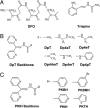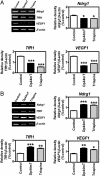A class of iron chelators with a wide spectrum of potent antitumor activity that overcomes resistance to chemotherapeutics
- PMID: 17003122
- PMCID: PMC1595448
- DOI: 10.1073/pnas.0604979103
A class of iron chelators with a wide spectrum of potent antitumor activity that overcomes resistance to chemotherapeutics
Abstract
Novel chemotherapeutics with marked and selective antitumor activity are essential to develop, particularly those that can overcome resistance to established therapies. Iron (Fe) is critical for cell-cycle progression and DNA synthesis and potentially represents a novel molecular target for the design of new anticancer agents. The aim of this study was to evaluate the antitumor activity and Fe chelation efficacy of a new class of Fe chelators using human tumors. In this investigation, the ligands showed broad antitumor activity and could overcome resistance to established antitumor agents. The in vivo efficacy of the most effective chelator identified, di-2-pyridylketone-4,4,-dimethyl-3-thiosemicarbazone (Dp44mT), was assessed by using a panel of human xenografts in nude mice. After 7 weeks, net growth of a melanoma xenograft in Dp44mT-treated mice was only 8% of that in mice treated with vehicle. In addition, no differences in these latter animals were found in hematological indices between Dp44mT-treated mice and controls. No marked systemic Fe depletion was observed comparing Dp44mT- and vehicle-treated mice, probably because of the very low doses required to induce anticancer activity. Dp44mT caused up-regulation of the Fe-responsive tumor growth and metastasis suppressor Ndrg1 in the tumor but not in the liver, indicating a potential mechanism of selective anticancer activity. These results indicate that the novel Fe chelators have potent and broad antitumor activity and can overcome resistance to established chemotherapeutics because of their unique mechanism of action.
Conflict of interest statement
The authors declare no conflict of interest.
Figures





References
-
- Le NT, Richardson DR. Biochim Biophys Acta. 2002;1603:31–46. - PubMed
-
- Buss JL, Greene BT, Turner J, Torti FM, Torti SV. Curr Top Med Chem. 2004;4:1623–1635. - PubMed
-
- Kalinowski DS, Richardson DR. Pharmacol Rev. 2005;57:547–583. - PubMed
-
- Thelander L, Reichard P. Annu Rev Biochem. 1979;48:133–158. - PubMed
-
- Richardson DR, Milnes K. Blood. 1997;89:3025–3038. - PubMed
Publication types
MeSH terms
Substances
LinkOut - more resources
Full Text Sources
Other Literature Sources

